Abstract
With the rapid development of port construction and the shipping industry, port water quality issues are of great concern. This is always a challenging task due to the frequent human activities and dynamic processes involved. A parallel intelligent water quality monitoring system is therefore proposed to ensure the effective monitoring and intelligent control of water pollutants. The real monitoring system and the artificial monitoring system of port water quality are established by applying artificial systems, computational experiments and parallel execution (ACP method). Both systems interact with each other and execute in parallel. The artificial monitoring system simulates complex scenarios, while the real monitoring system feeds the artificial monitoring system with actual monitoring data. By means of data-driven and model-driven approaches, the two systems can compute, observe and evaluate to control, manage and train models. Through the continuous optimization between the two systems, the efficiency and accuracy of the water quality monitoring system could be improved. Technical support can be further provided for the planning of water quality monitoring sites, implementation of monitoring tasks, allocation of emergency resources, etc. As in-situ monitoring data are obtained, computational experiments and parallel executions could be conducted to achieve the ultimate goal of port water quality management.
1. Introduction
As a major hub for bulk cargo transportation, ports play an important role in the comprehensive transportation network [1]. Under the background of the initiative of “The Belt and Road”, the shipping industry in China has developed rapidly, while a consensus has been reached on the significance of water quality monitoring in the port waters. The goal of green ports is not only one of the key ways to build comprehensive transportation networks and achieve carbon neutrality, but it is also a crucial measure to ensure the sustainable development of ports [2].
Green Ports in Theory and Practice notes that ports play a greater role than simply handling cargo at the quayside and that the port’s role in the transport chain has the potential to shape the social and environmental performance of transport systems around the world [3]. Thus, increasing attention has been paid to the port’s environmental management. As early as 2002, the U.S. EPA introduced the Surface Water Monitoring Strategy, which details the monitoring objectives, monitoring categories, data requirements, etc., for the surface water environment [4]. Real-time and effective monitoring of the water quality would reveal both spatiotemporal patterns in a timely manner, and the judicious use of monitoring data can provide great insights for optimizing the allocation of emergency resources, as well as Green Port guidelines [5,6]. The port environmental monitoring and early warning are achieved through the construction of port environmental monitoring systems [7,8,9] and most of these systems rely on large-scale distributed sensors. It is worth noting that the traditional fixed-point sampling monitoring method has limitations in the global perception of port water quality. The flexibility and customizability of the system are relatively poor [10].
The concept of a parallel system was initially proposed in 2004 [11,12,13] and has been developed over the following decade. As an intelligent and digital application framework, the parallel system has proven to be applicable in many scenarios and has been further applied to solve complex system problems [14]. Ning et al. [15] and Zhu et al. [16] applied the concept of a parallel system in the planning of a complex transportation system. Liu et al. [17] extended the parallel system by adding an interactive optimization module and successfully applied it to the research and development (R&D) of complex devices. Parallel system theory has also been successfully applied to the lifecycle risk management and process control of products by Cheng et al. [18]. There are many applications of parallel systems in daily life scenarios, such as a parallel parking system [19], parallel medical system [20], parallel environmental protection system [21], etc.
The intelligent monitoring system of water quality is noted as a typical complex system that not only involves several engineering disciplines such as power electronics, microcontrollers, control engineering and advanced testing techniques, but also has an inseparable connection with social disciplines such as economy, climate and population. Due to the complex nature of the system components, it is always challenging to simulate the dynamic processes of water quality using traditional models. The parallel system theory does not take a high degree of approximation to the real system as a measure for evaluating the model; it only requires the consistency between the model and the actual system in terms of system characteristics and data logic, which is consistent with the modelling characteristics of complex systems. The core components of a parallel system generally include artificial systems, computational experiments and parallel execution, referred to as the ACP method [22], on the basis of which the parallel system can be constructed and realized [23]. In the present study, the parallel system theory was introduced to establish a parallel intelligent water quality monitoring system based on the ACP method. An exploratory study of the system was also conducted for port waters. The practical application of the system would facilitate port environmental management.
2. Parallel Intelligent Monitoring System of Water Quality
The water quality monitoring system of green ports is recognized as a complex nonlinear system. Large deviations might appear when classic analysis methods are applied to explore the dynamic processes involved. Meanwhile, it is always difficult to reveal the non-linear characteristics, which directly affect the simulation effectiveness and efficiency [24]. The concept of an artificial system thereby provides a novel alternative to the modelling of complex systems. It starts from the underlying mechanism of behaviour generation, on the basis of which the artificial objects are constructed. Both artificial and real objects form a parallel system with real and imaginary reflections, equivalence and parallelism. Subsequently, the ACP method is utilized to achieve the modelling and analysis of complex systems in a fundamental way [25,26].
The water quality monitoring system can be functionally divided into the following subsystems: sensor subsystem, data acquisition subsystem, data transmission subsystem, data processing subsystem, ship scheduling subsystem, ship AIS (Automatic Identification System) data subsystem, meteorological subsystem and personnel subsystem (as shown in Figure 1).
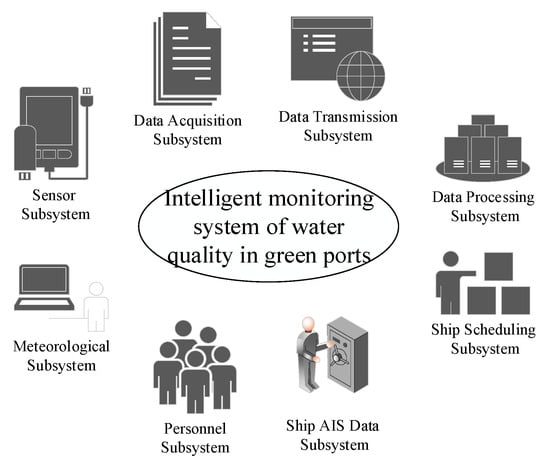
Figure 1.
The configuration of the intelligent water quality monitoring system.
2.1. Architecture of the Monitoring System
Based on the parallel system architecture theory [27], the parallel intelligent monitoring system of port water quality generally consists of a demand layer, infrastructure layer, data layer, algorithm layer and output layer. The architecture diagram of the system is depicted in Figure 2.
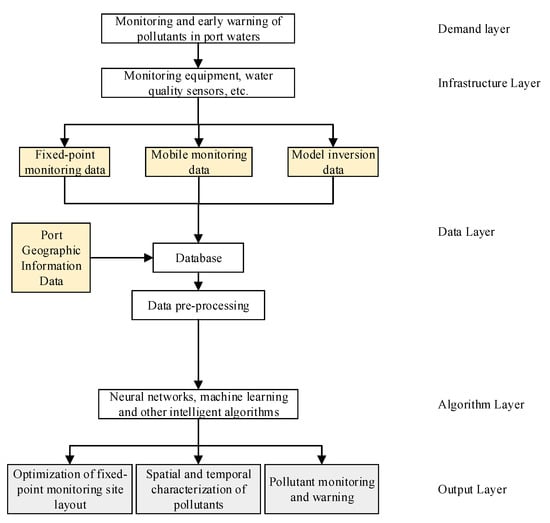
Figure 2.
Architecture diagram of parallel intelligent monitoring system of port water quality.
In the parallel intelligent monitoring system of water quality, the demand layer illustrates the system objectives. In the present study, the objective is summarized as the comprehensive monitoring and early warning of pollutants in the port waters. Thus, the infrastructure layer defines the instruments and equipment required for water quality monitoring, transmission, etc. The data layer includes data acquisition, pre-processing and storage. The data sources generally include fixed point monitoring data (e.g., wave buoy sensors and fixed-point sampling), mobile monitoring data (e.g., shipboard sensors) and model inversion data. Both water quality and geographic data are stored for pre-processing (i.e., data cleaning and sorting). The algorithm layer provides all necessary algorithms to build a parallel intelligent monitoring system, which is a core component of the whole system. The output layer provides a guideline for the optimal allocation of port monitoring resources and intelligent control of pollutants in port waters.
2.2. Components of the Parallel System
The parallel intelligent monitoring system of port water quality is established by the parallel theory and ACP method. An interaction between the real monitoring system and the artificial monitoring system is achieved. The framework of the parallel intelligent monitoring system based on the ACP method is demonstrated in Figure 3.
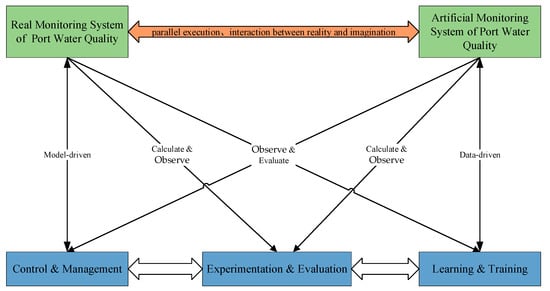
Figure 3.
The framework of parallel intelligent monitoring system of port water quality.
The whole system mainly includes the real monitoring and the artificial monitoring systems of port water quality. These two systems are constantly calculated, inspected and evaluated through data-driven and model-driven models to achieve model controlling, management and training [28]. Both systems interact with each other and run in parallel. Two systems compare and analyse, learn and evaluate their behaviour, and adjust their respective management and control methods to optimize the water quality monitoring system in ports. The main processes are further described as follows:
- (1)
- Learning and training
In the process of learning and training, the artificial water quality monitoring system in port waters is the core of the whole complex system, which realizes the management and control of the whole process. By combining the real monitoring system with the artificial monitoring system, the operating status of the system can be dynamically predicted and appropriate measures can be taken. The operation of the artificial monitoring system could improve the reliability and practicality of the real system. In the case of an unexpected pollution event in the port waters, the artificial system could provide potential optimal solutions to relieve the relevant impact.
- (2)
- Experiment and evaluation
At the stage of experiment and evaluation, the artificial system analyses the responses and evaluates the relevant impacts under different scenarios. The evaluation results could provide supports for system management, especially for the pollution control strategies in port waters.
- (3)
- Control and management
At the stage of control and management, the main function of the artificial system is to provide reliable predictions. By analysing the characteristics of the real monitoring and the artificial monitoring systems, the most effective solution to water pollutant evolution can be obtained by following certain rules (e.g., trial and error method, etc.). Thus, the intelligent management of a water quality monitoring system in port waters can be accomplished remotely through parallel executions.
2.3. Model Construction
A parallel system can be implemented by using an agent-based modelling approach. The concept of the agent was initially proposed by Minsky in 1984 and it has been rapidly developed and widely applied [29].
The agent-based modelling method does not require the artificial system and the real system to be highly realistic. Both systems only need to be “equivalent” in terms of functionality and behavioural logic [30].
The parallel water quality monitoring system consists of seven modules, named the port equipment module, vessel traffic module, personnel module, environment module, scheduling strategy module, event module and database rules. The relationship between these modules is further illustrated in Figure 4.
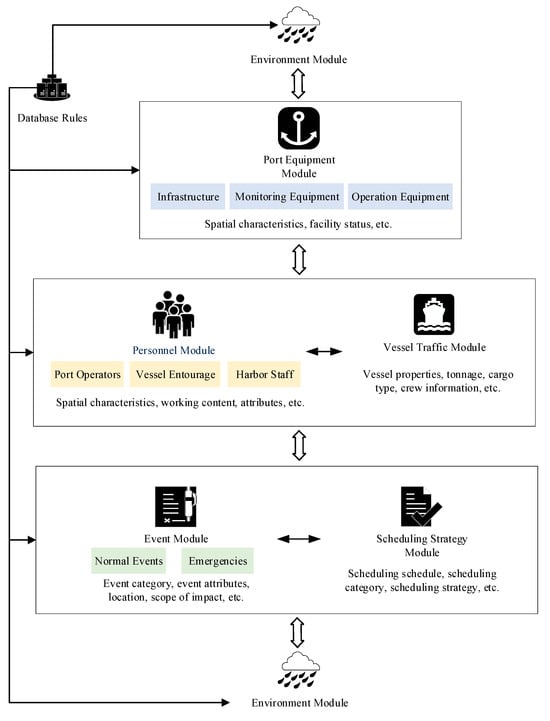
Figure 4.
Correlation analysis between different modules in the artificial monitoring system.
- (1)
- Port equipment module
The port equipment module mainly includes port infrastructure, port operation equipment and a monitoring instrument. The construction of the port equipment module is beneficial for the operation, control, maintenance and management of the equipment. The basic information (e.g., location, type, size, function and status) of each port equipment is necessary for the construction of the port equipment module.
- (2)
- Scheduling strategy module
In the port waters, there are always different types of vessels, such as transportation vessels (e.g., oil tanker, bulk carrier, container ship, etc.), pilot vessels and port management enforcement vessels, whose operations and management requirements are totally distinct. Therefore, the scheduling strategy plays an important role in the normal operation of port vessels. The scheduling strategy module needs to be adjusted according to the dynamic features of the system, for example, adjusting the number of pilot vessels, vessel routes, port equipment maintenance according to the number of inbound and outbound vessels, and loading and unloading requirements.
- (3)
- Vessel traffic module
Both inbound and outbound vessels need joint support of the scheduling strategy module, port equipment module, personnel module, etc. The formulation of entry and exit routes has a great impact on the efficiency of port operation and water quality monitoring [31]. The detailed vessel traffic flow information (including vessel static and dynamic information) can be obtained through the AIS data.
- (4)
- Environment module
The environmental module generally consists of two parts: the external factors and internal factors. The external factors describe various natural conditions of the port, including hydrology, meteorology, etc. The internal factors include various water quality indicators of concern. The environment module interacts with vessels, personnel and equipment to form a dynamic library of the environment in the port area.
- (5)
- Event module
All system-correlated events are integrated and abstracted to build an event module through big data analysis. Thus, the occurrence, coordinate, type and impact extent of various events could be revealed. Meanwhile, the event module should interact and feedback with the personnel, environment and equipment modules.
- (6)
- Personnel module
Personnel is an essential factor in the parallel intelligent monitoring system of port water quality and it mainly includes three types of personnel: port operators, ship attendants and port administration staff. Since the personnel status, job details and attributes are different, separate modelling is required for the personnel mentioned above. In addition, the self-learning ability should be emphasized and considered in the process of building the personnel module.
- (7)
- Database rules
The relevant historical data, operation rules and expert experience of the aforementioned six parts are uniformly stored as the database rules.
In the parallel intelligent monitoring system of port water quality, modules interact to form the whole monitoring system. The interaction between the modules mainly includes the following aspects: Firstly, the changes in the external environment will alter the spatial layout and operational status of the port infrastructure; therefore, the port equipment and the internal environment modules will interact and feedback with each other. Secondly, the port equipment, spatial layout and operational status will determine the general patterns of vessel traffic flow and personnel in the port waters. Meanwhile, the vessel traffic flow and personnel characteristics will also alter the operational status of the facility. Thirdly, the behaviour of personnel and vessel traffic flow is affected by the occurrence of events and scheduling strategies in the port and vice versa (as shown in Figure 4).
In the parallel intelligent monitoring system of port water quality based on the ACP method, data-driven, parallel computing, and other scientific and technical methods provide technical support for artificial system modelling and the execution of this complex system. The feature extraction of modelling objects via agent-based modelling is further utilized to construct a model of complex system behaviour characteristics that is consistent in terms of scale, behaviour mode and system characteristics [22]. Once the modelling is achieved, the credibility of the model would be verified (as shown in Figure 5). The model should not only satisfy the individual consistency, but also the local consistency of the subsystems and the overall consistency of the whole system, which guarantees the effectiveness of computational experiments and parallel executions.
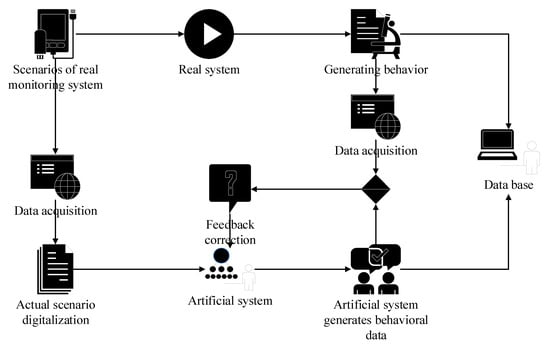
Figure 5.
Verification diagram of the artificial monitoring system.
2.4. Computational Experiments
After the credibility verification, the parallel intelligent monitoring system of port water quality can be applied to various hypothetical scenarios. Through repeated experiments, the validation and evaluation of each scenario can be completed with low cost and high efficiency. The process of the computational experiment is depicted in Figure 6.
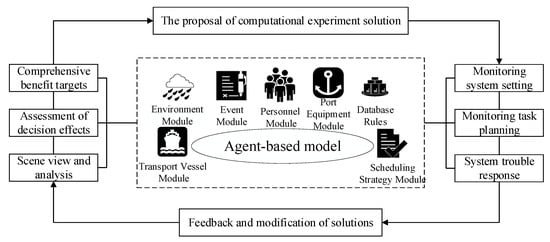
Figure 6.
The computational experiments of the parallel intelligent monitoring system.
According to the characteristics of the monitoring system, the computational experiment scenario of the parallel monitoring system in ports may include four aspects: the formulation of general monitoring tasks, layout of monitoring sites, emergency response of equipment failures and the contingency planning of pollution events.
- (1)
- Formulation of general monitoring tasks
Daily water quality monitoring tasks in ports include typical indicator monitoring and early warning of overflows. The monitoring system detects and collects information from water quality monitoring equipment within the port area and provides online processing, cloud storage and early warning eventually.
- (2)
- Layout of monitoring sites
According to the scheduling strategy and ship information, the water pollution risk map can be subsequently generated. To minimize the monitoring cost, the layout of the water quality monitoring sites could be optimized following the pollution risk calculation and the cluster analysis.
- (3)
- Emergency response of equipment failures
Green port equipment mainly includes port infrastructure, port operation equipment and monitoring system equipment. Once the port equipment failure occurs, the port operation and vessel scheduling are affected. Troubleshooting procedures will take up certain port resources and affect the normal operation of the entire surveillance system.
- (4)
- Contingency planning of pollution events
Human factors, environmental factors or other force majeure factors may contribute to the water pollution events in ports. Once a pollution incident occurs, contingency plans and countermeasures should be initiated immediately.
Considering the efficiency of computational experiments, the artificial port water quality monitoring system serves as a repeatable experimental platform, and the experimental scheme, results and parameters should be stored in the corresponding database to provide a fundamental support for subsequent parallel execution.
2.5. Parallel Execution
Parallel execution can be divided into three categories: total parallel execution, partial parallel execution and mixed parallel execution [32]. In the operation of the parallel intelligent monitoring system of port water quality, both the artificial monitoring system and the real monitoring system are equivalent. The development and optimization of the monitoring scheme of the real monitoring system (green textboxes in Figure 7) are based on the evaluation results of the artificial monitoring system (blue textboxes), which would support the decision-making process and comparative analysis of stakeholders. Meanwhile, the data of the real monitoring system could be adopted as the input of the artificial system, providing a theoretical reference for the structure optimization, parameter determination and model calibration of the artificial monitoring system. The processing diagram of the parallel execution in the system is demonstrated in Figure 7.
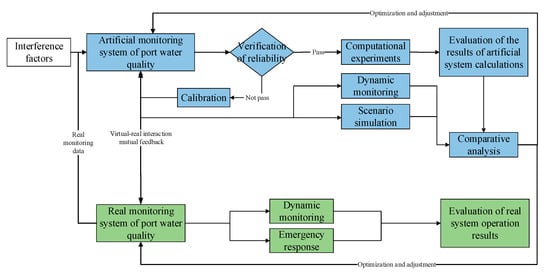
Figure 7.
The processing diagram of parallel execution.
The parallel system based on the ACP method is a complex system of parallel interactions between the real and artificial systems, both of which support each other, as well as the roll optimization and virtuous cycle. The artificial monitoring system of port water quality is an important part of the whole monitoring system and a complete evaluation guide should be designed to ensure that the goal of parallel implementation is successfully achieved. The evaluation process is mainly conducted through three dimensions of economy, sociality and sustainability (as shown in Figure 8).

Figure 8.
Evaluation procedure of artificial monitoring system of port water quality.
The artificial monitoring system of port water quality sets up problems, and analyses, evaluates and obtains results through parallel executions. It subsequently performs weighted calculation, result evaluation and program optimization through the evaluation system. Thus, the control schemes and management plans of the real monitoring system can be finalized.
3. Exploration of Application Scenarios
In early 2013, the Ministry of Transport, P.R. China, issued the “Guidance on Accelerating Green, Circular and Low-Carbon Transport Development”, which proposed to accelerate the construction of a resource-saving and environmentally friendly transportation industry and achieve green, circular and low-carbon transportation development [33]. Environmental monitoring is crucial for the environmental protection of the transportation industry, which needs to be comprehensively and systematically enhanced. After years of development, great progress has been made in terms of upgrading the monitoring equipment, optimizing the monitoring system and informatizing the environmental monitoring system. Meanwhile, massive monitoring data have laid a solid foundation for environmental protection research.
The US Congressional Research Service also issues relevant laws on water quality in detail [34], which plays an important role in water environment management and pollution control in ports. With the increasing concerns regarding green ports, it is imperative to conduct water quality monitoring, although challenges still exist in the real-time monitoring of relevant indicators [35]. The systematic analysis and overall design of water quality monitoring in port waters are meaningful.
Port water quality monitoring is recognized as a complex task due to frequent human activities and dynamic marine meteorological processes. The parallel intelligent monitoring system of water quality based on the ACP method could contribute to resolving these problems technically. The artificial system is constructed through the agent-based modelling theory, while both real and artificial systems give feedback to each other. Through the computational experiments and parallel executions, the management and computational evaluation of port water quality under complex conditions could be realized, which would eventually provide a guideline for the establishment of a port water quality monitoring system.
3.1. Planning of Port Monitoring Sites
The layout of port water quality monitoring sites has a major impact on the timeliness and reliability of water quality monitoring data. The traditional method of selecting monitoring sites generally considers the convenience of implementation. Factors such as pollutant migration and dispersion mechanisms may not be seriously considered. Some scientists use the grid format to select monitoring sites uniformly or randomly. The monitoring data are not instantaneous and the monitoring accuracy depends on manual operation and equipment accuracy, which provide little reference for real-time water quality monitoring and management [36]. To solve these problems, the layout of water quality monitoring sites has been studied and optimized. The layout optimization models have been explored through different methods, e.g., principal component analysis [37], artificial potential field method [38], multivariate statistical method [39], dynamic proximity method [40] and artificial neural network [41,42]. However, massive field observation data are always required to establish such a layout optimization model. The application of an artificial monitoring system could greatly reduce the time cost and economic cost in the layout planning of monitoring sites. Meanwhile, feasible alternatives can be evaluated in advance to avoid wasting resources due to duplicate implementation (as shown in Figure 9).

Figure 9.
Flow chart of monitoring site planning and optimization.
3.2. Formulation of Port Monitoring Task Plan
The dynamic monitoring and intelligent control of port water quality face great challenges due to the differences in the port’s general layout and the limitations of existing sampling and monitoring methods. The parallel system could provide guidelines for the planning and implementation of monitoring tasks prior to port construction. The flow chart of the water quality monitoring task planning is further demonstrated in Figure 10.
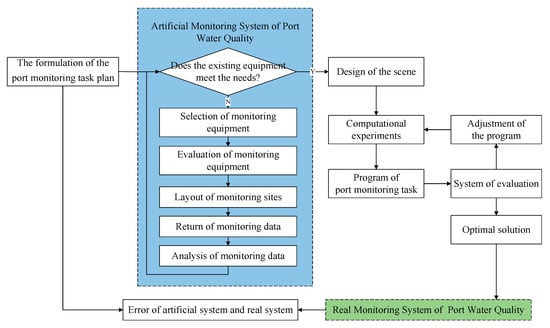
Figure 10.
Flow chart of the port monitoring task formulation.
3.3. Response to Port Water Pollution Emergency
The operational status of each subsystem will have an impact on the overall water quality monitoring system in port waters [43]. Pollution events mainly include ship spills, oil spills caused by ship collisions and improper sewage discharges in port areas. Once a pollution event occurs, a contingency plan must be provided in the shortest possible time with the goal of minimizing the overall damage. In the parallel system, reasonable influencing factors can be defined; thus, computational experiments and optimal solution evaluation can be readily performed. The optimal allocation of port emergency resources can be achieved following the contingency plan and can provide a technical reference for handling water pollution incidents. The response procedure of the port water pollution incident is explained in Figure 11.
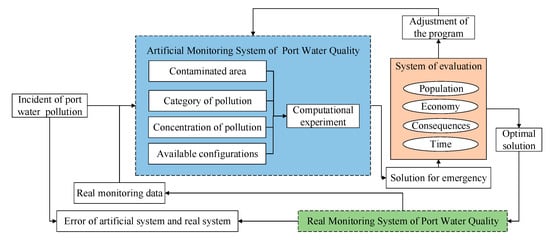
Figure 11.
The response procedure of port water pollution emergency.
4. Discussion
Water quality monitoring in port waters plays a crucial role in ensuring environmental safety and ecological health. Numerous countries worldwide have officially issued regulatory standards for port water quality management. Moreover, several port groups have established water quality monitoring programs and collaborated with local environmental authorities to ensure the compliance with water quality standards. Port water quality indicators typically include dissolved oxygen (DO), turbidity and chemical oxygen demand (COD), etc. These indicators might originate from various sources, such as ship ballast water discharges, industrial operations within the port areas and urban runoff associated with port activities. It is obvious that the only real monitoring system of water quality cannot cope with problems of pollutant source tracing [44] and the optimal allocation of emergency resources [45]. However, the parallel intelligent monitoring system of port water quality based on the ACP method can solve the above problems well.
A representative case of an environmental management system has been established at Huanghua Port, which is one of the largest coal transportation ports in North China. It is well known for its remarkable achievements in green port practices [46] and has gained impressive recognition as a leading international trade port. Novel environmental protection technologies (e.g., dust pollution treatment, air pollution treatment and sewage treatment) have been developed and adopted in practice. Data interaction is realized between the dust depression system and ecological water system to promote port sustainability. However, the monitoring of classical water quality indicators in port waters has not yet been accomplished. Moreover, the current strategy of the dust depression system could be classified as a one-way measure. The impacts of environmental factors (e.g., wind speed and direction, humidity, etc.) are not considered. The monitoring accuracy and management effectiveness could degrade due to the limited sensors deployed within the port area. For a better understanding of green port practices, it is important to establish a parallel intelligent monitoring system of port water quality.
The practical application of an intelligent monitoring system of port water quality is challenging. Firstly, the general layout of a port is always case-dependent; thus, it is unrealistic to put forward a general monitoring strategy for all ports. Secondly, the major water pollutants are closely related to the cargo types, seasons, hydrological and meteorological conditions. Therefore, appropriate monitoring techniques should be adopted for different pollutants within different ports. Thirdly, factors such as physical and chemical processes, wind and wave currents make the migration and diffusion mechanism of water pollution more complicated. The conversion efficiency and digestion rate of specific pollutants would also be affected by temperature, pH, light and other factors. Finally, the ultimate goal of an intelligent monitoring system of port water quality is to promote a dynamic and optimized balance between environmental protection and port production operations, rather than sacrificing the port’s status as an important node in the integrated transportation system. A parallel intelligent monitoring system based on the ACP method is expected to be a powerful method that provides useful insights into port water quality monitoring and management.
As demonstrated in Section 2, the parallel intelligent monitoring system of port water quality is distinct with traditional monitoring systems. The “equivalence” between two water quality monitoring systems (i.e., a real port water quality monitoring system and an artificial port water quality monitoring system) needs be established in the dimensions of physical and virtual space. Both systems are implemented in parallel to realize the interaction and feedback, which ultimately make the planning and implementation of the port water quality monitoring system simple, scientific and efficient. Considering the complex and dynamic processes involved in the port operations, a large number of interdisciplinary generalized models need to be built step by step for subsystems, as introduced in Section 2. So far, successful applications of the parallel system theory in other fields [22,47,48,49] have provided an exemplary basis for the intelligent parallel port water quality monitoring system proposed in the present study. The framework and application exploration of the parallel monitoring system of port water quality are beneficial to the sustainable development of ports. It should be emphasized that the application of smart technologies (e.g., Internet of Things, 5G, remote sensing, etc.) will effectively promote port environmental monitoring and sustainable development.
5. Conclusions
With the development of the global maritime industry, water quality monitoring and intelligent control have been highlighted as being important for a sustainable waterborne transportation system. Advanced water quality monitoring technology could improve the port’s capabilities in monitoring, scheduling and in the emergency response. In the present study, the theory of a parallel system based on the ACP method has been adopted for water quality monitoring in the port area. By introducing the system architecture and demonstrating the agent-based modelling method, an artificial monitoring system, which is equivalent to the real water quality monitoring system, is established. The scenes are set up according to the characteristics of the system. The computational experiments and parallel execution are further explained. Both real and artificial water quality monitoring systems interact and feedback with each other, forming a bottom–up parallel intelligent water quality monitoring system in port waters. The evaluation, comparison and analysis of these two systems will provide the experimental environment and theoretical basis for planning port water quality monitoring sites, implementing monitoring tasks and optimizing emergency resource allocation.
The artificial monitoring system is replicable and flexible. The development and application of intelligent technologies would promote in situ data collection, while the process of computational experimentation and parallel execution can provide reasonable and feasible control solutions for different monitoring scenarios and ports. By evaluating and analysing the economy, reliability and feasibility of the parallel monitoring system and methods involved, the effectiveness of the parallel intelligent water quality monitoring system based on the ACP method will be further verified. The parallel intelligent monitoring system will eventually improve the environmental monitoring and protection capabilities, thus facilitating the development of green ports worldwide.
Author Contributions
Conceptualization, J.G. and Z.J.; methodology, J.G. and X.C.; writing—original draft preparation, J.G.; writing—review and editing, J.G., Z.J., X.C. and W.W.; funding acquisition, Z.J. All authors have read and agreed to the published version of the manuscript.
Funding
The present study was financially supported by the National Key Research and Development Program of China (2021YFB2600200) and the National Natural Science Foundation of China (52071250, 51709220).
Informed Consent Statement
Not applicable.
Data Availability Statement
Access to the data will be considered upon request.
Conflicts of Interest
The authors declare no conflicts of interest.
References
- Shaikh, S.M.S.; Tagde, J.P.; Singh, P.R.; Dutta, S.; Sangolkar, L.N.; Kumar, M.S. Impact of Port and Harbour Activities on Plankton Distribution and Dynamics: A Multivariate Approach. Mar. Pollut. Bull. 2021, 165, 112105. [Google Scholar] [CrossRef]
- Yudhistira, M.H.; Karimah, I.D.; Maghfira, N.R. The Effect of Port Development on Coastal Water Quality: Evidence of Eutrophication States in Indonesia. Ecol. Econ. 2022, 196, 107415. [Google Scholar] [CrossRef]
- Bergqvist, R.; Monios, J. Green Ports in Theory and Practice. In Green Ports; Elsevier: Amsterdam, The Netherlands, 2019; pp. 1–17. [Google Scholar] [CrossRef]
- Behmel, S.; Damour, M.; Ludwig, R.; Rodrigue, M. Water quality monitoring strategies—A review and future perspectives. Sci. Total Environ. 2016, 571, 1312–1329. [Google Scholar] [CrossRef]
- Deshmukh, A.S.; Dayioglu, A.Y.; Aydilek, A.H. Geoenvironmental Behavior of Lime-Treated Marine Sediments. Mar. Georesour. Geotechnol. 2021, 39, 682–695. [Google Scholar] [CrossRef]
- Li, Y.; Zhu, W.; Wu, S.; Shu, S.; Lv, Y.; Cui, Y. Environmental Impact of Fluidized Solidified Silt Casting on Surrounding Water Bodies. Mar. Georesour. Geotechnol. 2020, 38, 604–610. [Google Scholar] [CrossRef]
- Wang, Y.; Chen, T. Design of GIS Component-based Port Environmental Pollution Monitoring System. Comput. Netw. 2011, 37, 62–64. [Google Scholar]
- Xie, J.; Yan, X.; Teng, F.; Mei, L. Green Port Environment Monitoring System with Early Warning and Linkage Control. In Proceedings of the 2015 12th IEEE International Conference on Electronic Measurement & Instruments (ICEMI), Qingdao, China, 16–18 July 2015; pp. 244–247. [Google Scholar] [CrossRef]
- Zhang, C. Port Eco-wise Monitoring and Control System. Port Sci. Technol. 2020, 10, 17–19. [Google Scholar]
- Zhang, H.; Zhang, D.; Zhang, A. An Innovative Multifunctional Buoy Design for Monitoring Continuous Environmental Dynamics at Tianjin Port. IEEE Access 2020, 8, 171820–171833. [Google Scholar] [CrossRef]
- Almalaq, A.; Hao, J.; Zhang, J.; Wang, F. Parallel Building: A Complex System Approach for Smart Building Energy Management. IEEE/CAA J. Autom. Sin. 2019, 6, 1452–1461. [Google Scholar] [CrossRef]
- Wang, F. Parallel Control and Management for Intelligent Transportation Systems: Concepts, Architectures, and Applications. IEEE Trans. Intell. Transp. 2010, 11, 630–638. [Google Scholar] [CrossRef]
- Wang, F. Agent-Based Control for Fuzzy Behavior Programming in Robotic Excavation. IEEE Trans. Fuzzy Syst. 2004, 12, 540–548. [Google Scholar] [CrossRef]
- Wang, F.; Tang, S. Artificial Societies for Integrated and Sustainable Development of Metropolitan Systems. IEEE Intell. Syst. 2004, 19, 82–87. [Google Scholar] [CrossRef]
- Ning, B.; Wang, F.; Dong, H.; Li, R.; Wen, D.; Li, L. Parallel Systems for Urban Rail Transportation Based on ACP Approach. J. Intell. Trans. Syst. Eng. Inf. Technol. 2010, 10, 22–28. [Google Scholar] [CrossRef]
- Zhu, F.; Wang, F.; Li, R.; Lv, Y.; Chen, S. Modeling and Analyzing Transportation Systems Based on ACP Approach. In Proceedings of the 2011 14th International IEEE Conference on Intelligent Transportation Systems (ITSC), Washington, DC, USA, 5–7 October 2011; pp. 2136–2141. [Google Scholar] [CrossRef]
- Liu, S.; Fang, Z.; Yuan, C.; Li, Y.; Cao, Y. Research on ACPI System Frame for R&D Management of Complex Equipments. Kybernetes 2012, 41, 750–760. [Google Scholar] [CrossRef]
- Cheng, C.; Wang, J.; Liu, X.; Mo, H.; Zhu, F.; Gang, X. ACP Approach Based Intelligent Quality Management System for Manufacturing Processes. In Proceedings of the 2014 IEEE International Conference on Service Operations and Logistics, and Informatics, Qingdao, China, 8–10 October 2014; pp. 244–247. [Google Scholar] [CrossRef]
- Yang, L.; Wang, F.; Zhang, Y.; Han, S.; Yang, J.; Zhao, K.; Cheng, X. The Urban Parallel Parking System Based on ACP Approach. J. Comm. Contr. 2015, 1, 384–390. [Google Scholar]
- Wang, S.; Wang, J.; Wang, X.; Qiu, T.; Yuan, Y.; Ouyang, L.; Guo, Y.; Wang, F. Blockchain-Powered Parallel Healthcare Systems Based on the ACP Approach. IEEE Trans. Comput. Soc. Syst. 2018, 5, 942–950. [Google Scholar] [CrossRef]
- Chang, F.; Kang, M.; Wang, X.; Lie, J.; Wang, F. Windblown sand control decision-making support system based on parallel intelligence: Taklimakan desert highway and its sand-breaking system. Chin. J. Intell. Sci. Technol. 2021, 3, 499–506. [Google Scholar]
- Jin, J.; Rong, D.; Pang, Y.; Ye, P.; Ji, Q.; Wang, X.; Wang, G.; Wang, F. An Agent-Based Traffic Recommendation System: Revisiting and Revising Urban Traffic Management Strategies. IEEE Trans. Syst. Man Cybern Syst. 2022, 52, 7289–7301. [Google Scholar] [CrossRef]
- Dong, X.; Lin, Y.; Shen, D.; Li, Z.; Zhu, F.; Hu, B.; Fan, D.; Xiong, G. A Parallel Transportation Management and Control System for Bus Rapid Transit Using the ACP Approach. IEEE Trans. Intell. Transp. Syst. 2017, 18, 2569–2574. [Google Scholar] [CrossRef]
- Wang, F.; Liu, D.; Xiong, G.; Cheng, C.; Zhao, D. Parallel Control Theory of Complex Systems and Applications. Complex Syst. Complex. Sci. 2012, 9, 1–12. [Google Scholar] [CrossRef]
- Wang, F. On the Modeling Analysis Control and Management of Complex Systems. Complex Syst. Complex. Sci. 2006, 3, 26–34. [Google Scholar] [CrossRef]
- Wang, F. Computational Theory and Methods for the Study of Complex Systems. China Basic Sci. 2004, 6, 5–12. [Google Scholar]
- Wang, F.; Yang, L.; Cheng, X.; Han, S.; Yang, J. Network Softwarization and Parallel Networks: Beyond Software-Defined Networks. IEEE Netw. 2016, 30, 60–65. [Google Scholar] [CrossRef]
- Li, L.; Lin, Y.; Zheng, N.; Wang, F. Parallel Learning: A Perspective and a Framework. IEEE/CAA J. Autom. Sin. 2017, 4, 389–395. [Google Scholar] [CrossRef]
- Rosenman, M.; Wang, F. CADOM: A Component Agent-Based Design-Oriented Model for Collaborative Design. Res. Eng. Des. 1999, 11, 193–205. [Google Scholar] [CrossRef]
- Su, Z.; Yang, R.; Wang, F. Parallel Marine Environment Monitoring Systems: Architecture and Application. J. Comm. Contr. 2018, 4, 32–36. [Google Scholar] [CrossRef]
- Chen, Q.; Mei, K.; Dahlgren, R.A.; Wang, T.; Gong, J.; Zhang, M. Impacts of Land Use and Population Density on Seasonal Surface Water Quality Using a Modified Geographically Weighted Regression. Sci. Total Environ. 2016, 572, 450–466. [Google Scholar] [CrossRef]
- Lun, S. Research on the Classification cation of Parallel Execution Modes of ACP Theory. Acta Autom. Sin. 2012, 38, 1602–1608. [Google Scholar] [CrossRef]
- Li, Y.; Chen, K.; Zheng, N.; Cai, Q.; Li, Y.; Lin, C. Strategy Research on Accelerating Green and Low-Carbon Development under the Guidance of Carbon Peak and Carbon Neutral Targets. IOP Conf. Ser. Earth Environ. Sci. 2021, 793, 012009. [Google Scholar] [CrossRef]
- Copeland, C. Clean Water Act: A Summary of the Law; Congressional Research Service: Washington, DC, USA, 2016. [Google Scholar]
- Guo, J. The Importance of Port Environmental Monitoring and the Main Problems of Monitoring. Pearl River Water Transp. 2020, 8, 48–49. [Google Scholar] [CrossRef]
- Wang, X.; Pang, Y.; Shen, C.; Zhuang, W.; Liu, W. Layout optimization of water environmental monitoring site of trans-boundary of Taihu Basin. Water Resour. Prot. 2017, 33, 130–137. [Google Scholar]
- Li, W.; Du, X.; Lin, M.; Zhang, C.; Zhang, L.; Liu, J.; Ding, H.; Zhang, S.; Li, Z. Spatial-temporal Variation Characteristic of Water Quality in Hongze Lake Based on PCA and SOM. Resour. Environ. Yangtze Basin 2013, 22, 1593–1601. [Google Scholar]
- Khatri, P.; Gupta, K.K.; Gupta, R.K. Development of Cyber-Physical Systems for Water Quality Monitoring in Smart Water Grid. In Recent Trends in Communication and Intelligent Systems; Algorithms for Intelligent Systems; Pundir, A.K.S., Yadav, N., Sharma, H., Das, S., Eds.; Springer Nature: Singapore, 2022; pp. 215–223. ISBN 978-981-19132-3-5. [Google Scholar]
- Galešić Divić, M.; Kvesić Ivanković, M.; Divić, V.; Kišević, M.; Panić, M.; Lugonja, P.; Crnojević, V.; Andričević, R. Estimation of Water Quality Parameters in Oligotrophic Coastal Waters Using Uncrewed-Aerial-Vehicle-Obtained Hyperspectral Data. J. Mar. Sci. Eng. 2023, 11, 2026. [Google Scholar] [CrossRef]
- Gu, S.; Li, Q. Study on layout of hydrologic network in the Changjiang estuary. J. East China Norm. Univ. Nat. Sci. 2015, 2015, 1–6. [Google Scholar]
- Pandey, D.; Mishra, S.; Pandey, S. Intelligent Control System for Water Pollutant Monitoring Using ANN and Fuzzy Logic. In Intelligent Algorithms for Analysis and Control of Dynamical Systems; Algorithms for Intelligent Systems; Kumar, R., Singh, V.P., Mathur, A., Eds.; Springer: Singapore, 2021; pp. 89–101. ISBN 9789811580444. [Google Scholar]
- Lin, J.; Liu, Q.; Song, Y.; Liu, J.; Yin, Y.; Hall, N. Temporal Prediction of Coastal Water Quality Based on Environmental Factors with Machine Learning. J. Mar. Sci. Eng. 2023, 11, 1608. [Google Scholar] [CrossRef]
- Wang, W.; Liu, B.; Peng, Y.; Jiang, Z. Design of Buoy Network in Port Water Area for Monitoring Air Pollution: A Robust Optimization Approach. Ocean Coast. Manag. 2023, 244, 106816. [Google Scholar] [CrossRef]
- Jing, L.; Kong, J.; Wang, J.; Xu, T.; Pan, M.; Chen, W. Joint Identification of Contaminant Source Based on the Ensemble Kalman Filter Integrated with Relation Coefficient. J. Hydrol. 2023, 617, 129057. [Google Scholar] [CrossRef]
- Shi, S.; Cao, J.; Feng, L.; Liang, W.; Zhang, L. Construction of a Technique Plan Repository and Evaluation System Based on AHP Group Decision-Making for Emergency Treatment and Disposal in Chemical Pollution Accidents. J. Hazard. Mater. 2014, 276, 200–206. [Google Scholar] [CrossRef]
- Zhao, D.; Wang, T.; Han, H. Approach towards Sustainable and Smart Coal Port Development: The Case of Huanghua Port in China. Sustainability 2020, 12, 3924. [Google Scholar] [CrossRef]
- Xiong, G.; Li, Z.; Wu, H.; Chen, S.; Dong, X.; Zhu, F.; Lv, Y. Building Urban Public Traffic Dynamic Network Based on CPSS: An Integrated Approach of Big Data and AI. Appl. Sci. 2021, 11, 1109. [Google Scholar] [CrossRef]
- Zheng, W.; Yan, L.; Gou, C.; Wang, F. An ACP-Based Parallel Approach for Color Image Encryption Using Redundant Blocks. IEEE Trans. Cybern. 2022, 52, 13181–13196. [Google Scholar] [CrossRef] [PubMed]
- Wang, K.; Gou, C.; Wang, F. Parallel Vision: An ACP-based Approach to Intelligent Vision Computing. Acta Autom. Sin. 2016, 42, 1490–1500. [Google Scholar] [CrossRef]
Disclaimer/Publisher’s Note: The statements, opinions and data contained in all publications are solely those of the individual author(s) and contributor(s) and not of MDPI and/or the editor(s). MDPI and/or the editor(s) disclaim responsibility for any injury to people or property resulting from any ideas, methods, instructions or products referred to in the content. |
© 2024 by the authors. Licensee MDPI, Basel, Switzerland. This article is an open access article distributed under the terms and conditions of the Creative Commons Attribution (CC BY) license (https://creativecommons.org/licenses/by/4.0/).